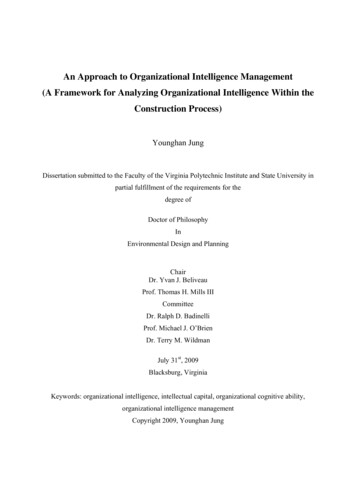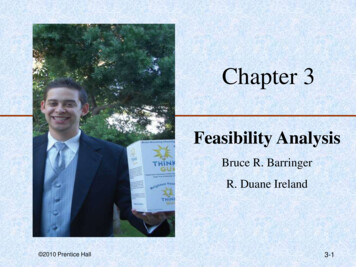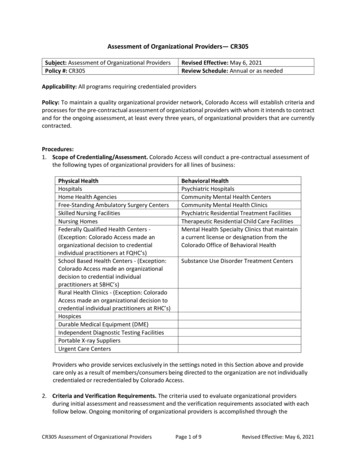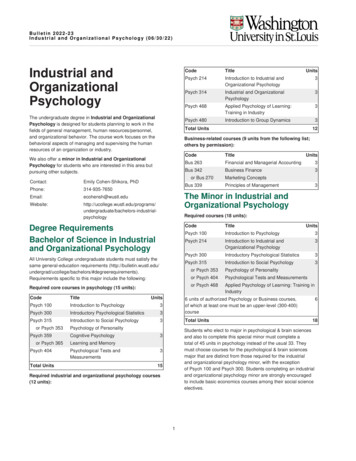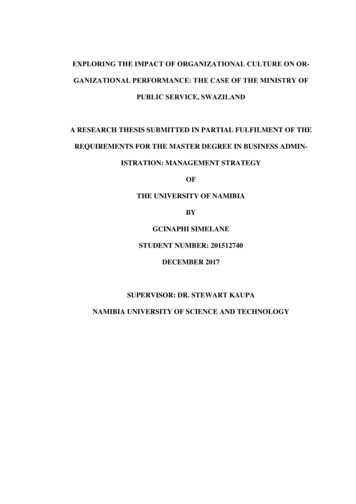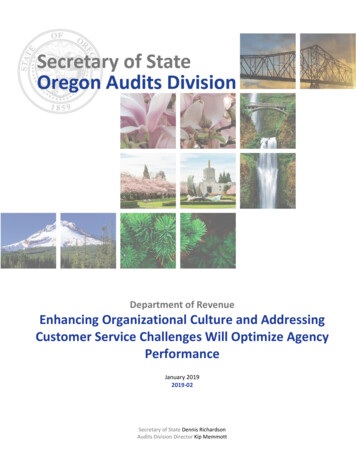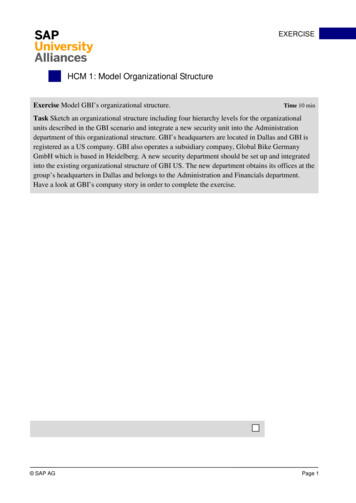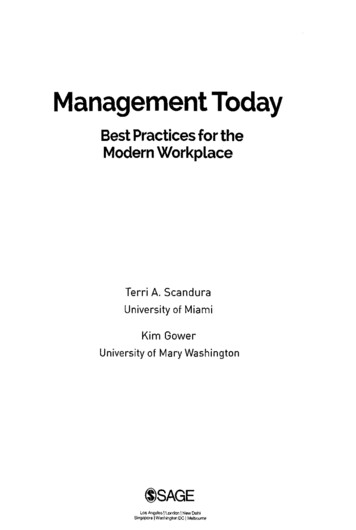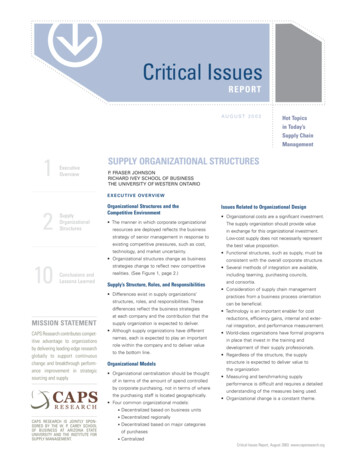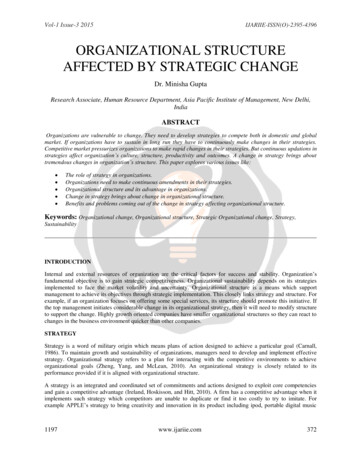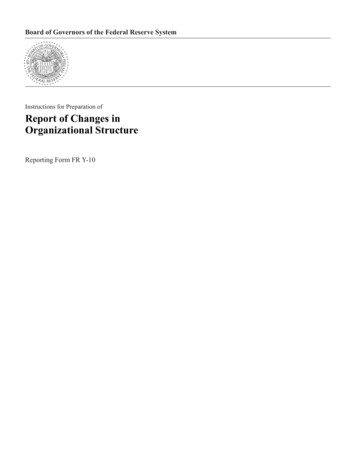
Transcription
Board of Governors of the Federal Reserve SystemInstructions for Preparation ofReport of Changes inOrganizational StructureReporting Form FR Y-10
INSTRUCTIONS FOR PREPARATION OFReport of Changes inOrganizational StructureFR Y–10GENERAL INSTRUCTIONSIntroductionUse the FR Y-10 to report changes to the worldwideorganizational structure of bank holding companies(BHCs), savings and loan holding companies (SLHCs),1U.S. intermediate holding companies (IHCs), memberbanks, Edge and agreement corporations, and to the U.S.operations of foreign banking organizations (FBOs).2Such changes include: information about the Reporter itself; acquisition of interests in BHCs, IHCs, SLHCs, FBOs,banks organized under U.S. law and savings associations; acquisition of interests in nonbanking companies thatare owned by BHCs, IHCs, SLHCs, and non-qualifyingFBOs, and nonbanking companies conducting businessin the United States that are owned by qualifyingFBOs; transfer, sale, or liquidation of such interests; merger of companies; internal reorganization; commencement of new activities;1. Grandfathered unitary savings and loan holding companies areincluded in SLHCs and are required to file the FR Y-10 with the appropriate Federal Reserve Bank.2. A FBO with U.S. operations that is not or ceases to be a “qualifyingforeign banking organization” (QFBO) within the meaning of RegulationK, and is not otherwise treated as a QFBO under Regulation K, shouldconsult with Federal Reserve staff regarding the scope of its FR Y-10reporting obligations. In general, a FBO that is not or is not treated as aQFBO is subject to the nonbanking restrictions of the BHC Act withrespect to its worldwide operations and, thus, would have to report on theFR Y-10 changes to its worldwide organizational structure.FR Y–10General Instructions October 2016 certain merchant banking or insurance company investments; establishment in the United States of branches, agencies, and representative offices of FBOs and activitiesthrough managed non-U.S. branches; opening, closing, or relocation of foreign branches ofmember banks, BHCs, IHCs, or Edge or agreementcorporations and of their foreign subsidiaries; opening, acquisition, sale, closing or relocation ofdomestic branches of U.S. subsidiary depository institutions of top-tier BHCs, IHCs, or SLHCs, of unaffiliated state member banks, and of Edge and agreementcorporations; and changes to previously reported information.Depending on the nature of reported changes in structureand activity information, it will not always be necessaryto file all schedules. Blank schedules should be omitted.The instructions are divided into the following sections: General Instructions describing overall reportingrequirements Specific Instructions for completingPage 1Banking ScheduleSavings and Loan ScheduleNonbanking ScheduleMerger Schedule4(k) ScheduleDomestic Branch ScheduleForeign Branch of U.S. Banking OrganizationsScheduleBranch, Agency, and RepresentativeOffice of FBOs Schedule (BARO Schedule) Glossary of terms used in these instructionsGEN-1
General Instructions Appendix A - Federal Reserve Board Legal AuthorityCodesThe same procedure should be followed by tiered organizations consisting of nonqualifying FBOs. Appendix B - Board to North American IndustryClassification System (NAICS) Activity Codes Conversion TableIn the case of a tiered FBO organization, where onequalifying FBO3 controls another qualifying FBO, thetop-tier FBO may file on behalf of all lower-tier FBOs orthe lower-tier FBOs may choose to file separately.If more than one transaction is reportable for a particularsubmission, multiple schedules should be submitted.Several supporting schedules may be included under onecompleted page 1 of the FR Y-10 report form.Who Must ReportThe following companies (termed Reporters for purposesof the FR Y-10) are required to file this report: Top-tier BHCs (including Employee Stock OwnershipPlans (ESOPs) or Employee Stock Ownership Trust(ESOTs) that are BHCs) organized under U.S. orforeign law that are not FBOs, regardless of financialholding company (FHC) status. Top-tier SLHCs, ESOPs, ESOTs, or trusts that areSLHCs pursuant to Regulation LL (12 CFR238.2(m)(2)). Security holding companies as authorized under Section 618 of the Dodd-Frank Wall Street Reform andConsumer Protection Act of 2010 (the Dodd-FrankAct), 12 U.S.C. 1850a(c)(1). FBOs (both qualifying and nonqualifying) (see theGlossary), whether or not a BHC. State member banks (SMBs) not controlled by a BHCor a FBO. Edge and agreement corporations not controlled by aBHC, FBO, or member bank. National banks not controlled by a BHC or FBO, butonly with respect to their foreign branches, their investments made under Subpart A of Regulation K, andforeign branches of their foreign subsidiaries that areinvestments made under Subpart A of Regulation K.In the case where a FBO owns lower-tier FBOs andBHCs, the top-tier FBO may file on behalf of itself andany lower-tier FBOs. The top-tier U.S. BHC or SLHC isresponsible for filing for itself and all lower-tier BHCs orSLHCs.In the case where an FBO establishes an IHC or designates an existing BHC as an IHC, the top-tier FBO mustfile on behalf of itself and the IHC. The IHC does not filethe FR Y-10 report.What Events Must Be ReportedThe following categories of events (termed ReportableEvents for purposes of the FR Y-10 and these instructions) generally trigger the requirement to file a FR Y-10.Note that a single transaction by a Reporter may involvemore than one reportable event. New Reporters: Any event that causes a company tobecome a Reporter. See the Changes in Reporter Statuspart of these instructions for further explanation andreporting directions. Interests in Banking Companies: Acquisition, sale, ortransfer of a controlling interest in, or more than 5percent of a class of voting securities of, an existing ornew BHC, bank organized under U.S. law, FBO (Banking Company for purposes of the FR Y-10), or IHCthat holds directly or indirectly a bank organized underU.S. law; changes in the level or type of ownershipinterest in a Banking Company; cessation of businessor liquidation of a Banking Company; changes in theprincipal activities of a Banking Company; and changesto information previously reported on Federal Reservestructure reports4 about a Banking Company. See theTiered OrganizationsIn the case of a tiered BHC or SLHC organization whereone BHC or SLHC that is not a FBO controls anotherBHC or SLHC that is not a FBO, the top-tier BHC orSLHC should file reports on behalf of all lower-tierBHCs or SLHCs.GEN-23. This reference to qualifying FBOs also pertains to FBOs that aretreated as qualifying FBOs as well as FBOs that have limited exemption.4. Prior to the issuance of this report form on June 30, 2007, changes toorganizational structure of banking and nonbanking companies were reported on four forms, i.e., FR Y-10, FR Y-10F, FR Y-10S, and FR 2058.The respondent panels for those forms and the information required to beFR Y–10General Instructions October 2016
General InstructionsBanking Schedule part of these instructions for furtherexplanation and reporting directions. Interests in Savings and Loan Companies: Acquisition,sale, or transfer of a controlling interest in, or morethan 5 percent of a class of voting securities of, anexisting or new SLHC, or savings association (Savingsand Loan Company for the purposes of the FR Y-10);changes in the level or type of ownership interest in aSavings and Loan Company; cessation of business orliquidation of a Savings and Loan Company; changesin the principal activities of a Savings and LoanCompany; and changes to information previouslyreported on Federal Reserve structure reports or theformer Office of Thrift Supervision reports about aSavings and Loan Company. See the Savings and LoanSchedule part of these instructions for further explanation and reporting directions. Interests in Nonbanking Companies: For BHCs orSLHCs, interests in Nonbanking Companies includesthe acquisition, sale, or transfer of a controlling interestin an existing or new company other than a BHC orSLHC, bank organized under U.S. law, FBO (Nonbanking Company for purposes of the FR Y-10), orIHC that holds directly or indirectly a bank organizedunder U.S. law; changes in the level or type of ownership interest in a Nonbanking Company; cessation ofbusiness or liquidation of a Nonbanking Company;changes in the principal activities of a NonbankingCompany; and changes to information previouslyreported on Federal Reserve structure reports about aNonbanking Company. See the Nonbanking Schedulepart of these instructions for further explanation andreporting directions. Mergers: A merger involving a Banking, Savings andLoan, or a Nonbanking Company in which the Reporterpreviously had reported an ownership interest on Federal Reserve structure reports. See the Merger Schedule part of these instructions for further explanationand reporting directions. 4(k) Activities: Commencement by a Reporter that is aFHC of an activity it has not previously conducted,whether the result of acquisition of an existing Nonbanking Company, formation of a new Nonbankingreported have been incorporated into this form. References to ‘‘informationpreviously reported on Federal Reserve structure reports’’ pertain to information reported on those four report forms.FR Y–10General Instructions October 2016Company, or commencement of a new activity by anexisting company. See the 4(k) Schedule of theseinstructions for further explanation and reporting directions. Merchant Banking or Insurance Company Investments:Certain large merchant banking investments, insurancecompany investments, or the event of a name change.See the 4(k) Schedule part of these instructions forfurther explanation and reporting directions. Domestic Branches: The opening, purchase, acquisition, sale, closure, relocation, name change, change inservice type, or deletion of erroneously reported information of domestic branches of domestic depositoryinstitutions of top-tier BHCs or SLHCs, of unaffiliatedstate member banks and of Edge and agreement corporations; and any changes to information previouslyreported on Federal Reserve structure reports aboutsuch branches. See the Domestic Branch Schedule partof these instructions for further explanation and reporting directions. A top-tier BHC or SLHC is responsiblefor filing branch information for its domestic subsidiary depository institutions’ U.S. offices. Also, unaffiliated state member banks and unaffiliated Edge andagreement corporations are responsible for filing fortheir offices. Foreign Branches of U.S. Banking Organizations: Theopening, closing, or relocation of foreign branches ofunaffiliated member banks, BHCs, or Edge or agreement corporations, or of foreign subsidiaries of suchorganizations; and any changes to information previously reported on Federal Reserve structure reportsabout such offices. See the Foreign Branches of U.S.Banking Organizations Schedule part of these instructions for further explanation and reporting directions. Branches, Agencies, and Representative Offıces: Theopening, closing (with or without license surrender), orliquidation of a branch, agency, or representative officelocated in the United States and the commencement ortermination of the management by a U.S. branch oragency of a non-U.S. branch of a FBO; and anychanges to information previously reported on FederalReserve structure reports about such offices. See theBranch, Agency, and Representative Office of FBOsSchedule part of these instructions for further explanation and reporting directions. Cessation of Status as a Reporter: Any event thatterminates a company’s status as a Reporter. See theGEN-3
General InstructionsChanges in Reporter Status part of these instructionsfor further explanation and reporting directions.Legal Entity Identifier (LEI)The Reporter must provide the LEI for all banking,nonbanking, and savings and loan legal entities reportable on the Banking, Non-Banking, SLHC, and 4Kschedules (not the Branch schedules) of the FR Y-10 ifone has already been assigned. If the Reporter or any ofits reportable entities does not have a LEI, it is notrequired to obtain one for the sole purpose of reportingthe LEI on the FR Y-10.LEIs issued or lapsed are reportable within 30 calendardays of the event on the appropriate FR Y-10 schedules.Changes in Reporter StatusThe following are Reportable Events: Becoming a Reporter: Any event that causes a company to become a Reporter. To report, a new Reporter(BHC, SLHC, FBO, unaffiliated SMB or Edge oragreement corporation, or National Bank) must complete a Banking, Savings and Loan, or NonbankingSchedule for itself, and a Banking, Savings and Loan,or Nonbanking Schedule for its subsidiary. If theReporter was a going concern prior to becoming aReporter, follow instructions for “Acquisition of aGoing Concern.” If the Reporter is a new company,follow instructions for “De Novo Formation.”In addition, a new Reporter must report interests in anycompanies that are going concerns at the time theReporter becomes a Reporter and must report any activity engaged in by the Reporter under Section 4(k) of theBHC Act or Section 10(c)(2)(H) of the Home Owners’Loan Act (‘‘HOLA’’). Report an interest in a goingconcern as if the Reporter acquired the interest simultaneously with becoming a Reporter by completing aBanking Schedule or Nonbanking Schedule, as appropriate, following directions for ‘‘Acquisition of a GoingConcern.’’ Report activities engaged in under Section4(k) of the BHC Act or Section 10(c)(2)(H) of HOLA asif commenced simultaneously with becoming a Reporterby completing a 4(k) Schedule, following directions for‘‘Acquisition of a Going Concern Resulting in a NewActivity.’’A foreign bank that becomes a FBO (and therebybecomes a Reporter) due to the establishment of an initialGEN-4U.S. branch or agency must also complete a Branch,Agency, and Representative Office of FBOs Schedulewith respect to the branch or agency. Such a foreign bankbecomes a Reporter when the initial branch or agencyopens for business, not when the branch or agency islicensed.If deemed warranted for supervisory purposes, the Federal Reserve may request an organization chart. BecauseFR Y-10 reporting requirements differ from the AnnualReport of Holding Companies - FR Y-6 and the AnnualReport of Foreign Banking Organizations - FR Y-7reporting requirements, the organization chart submittedwith the FR Y-10 may be different from the organizationchart submitted with the Reporter’s FR Y-6 or FR Y-7report. Cessation of Status as a Reporter: Any event thatterminates a company’s status as a Reporter. If termination of Reporter status results from sale or liquidation of a Reporter or from the Reporter becominginactive, complete a Banking Schedule, Savings andLoan Schedule, or Nonbanking Schedule, as appropriate, with respect to the Reporter. Follow the instructions for reporting the event type ‘‘External Transfer,’’‘‘Liquidation,’’ or ‘‘Became Inactive,’’ as appropriate,and also check the event type box next to ‘‘No LongerReportable.’’If termination of Reporter status results from sale orliquidation of a Reporter’s U.S. subsidiary bank, commercial lending company, or Edge or agreement corporationor savings association, complete a Banking Schedule,Savings and Loan Schedule, or Nonbanking Schedule, asappropriate, following the instructions for ‘‘ExternalTransfer’’ or ‘‘Liquidation,’’ as appropriate. In addition,submit a Banking Schedule, Savings and Loan Schedule,or Nonbanking Schedule, as appropriate, with respect tothe Reporter, but only check the event type box next to‘‘No Longer Reportable,’’ provide the date of the event,and provide the Reporter’s legal name and location inItems 2 and 3 of the Characteristics Section.If termination of Reporter status results from sale orclosure of a Reporter’s U.S. branch(es) or agency(s),complete a Branch, Agency, and Representative Office ofFBOs Schedule. In addition, submit a Banking Scheduleor Nonbanking Schedule, as appropriate, with respect tothe Reporter, but only check the event type box next to‘‘No Longer Reportable,’’ and provide the date of theFR Y–10General Instructions October 2016
General Instructionsevent and the Reporter’s legal name and location in theCharacteristics Section.Where and When to File this ReportThe appropriate Federal Reserve Bank (see the Glossary)must receive an original and one copy of this reportwithin 30 calendar days after a reportable event. Earliersubmission would aid the Federal Reserve in reviewingand processing the report.FR Y-10 Online Submission OptionThe Reporter may file the FR Y-10 electronically.Respondents interested in filing electronically must contact the appropriate Federal Reserve Bank in order toobtain a User ID and password. To access the FR Y-10Online website, use the following URL:https://y10online.federalreserve.govNote: Reports that contain a request for confidentialtreatment should not be submitted electronically.Alternative Submission OptionsAs an alternative, the reporter may file the FR Y-10 bymail, e-mail, or fax. The filing of a completed report willbe considered timely, regardless of when the report isreceived by the appropriate Federal Reserve Bank, if thereport is postmarked for mail or date/timestamped fore-mail and fax within 30 calendar days after a reportableevent.Information on the CUSIP number of the Reporter (BHC,SLHC, or unaffiliated state member bank); a BHC’slower-tier U.S. BHCs subsidiary U.S. banks; a SLHC’slower-tier U.S. SLHCs subsidiary, U.S. savings association; a FBO’s IHC; or a Reporter’s largest subsidiary U.S.nonbanking company that has a currently active CUSIPnumber must be assessed only once a year as of December 31. Changes to this data must be reported on anevent-generated basis within 30 calendar days of suchchanges.Confidential TreatmentOnce submitted, a FR Y-10 report becomes a FederalReserve Board (Board) record and may be requested byany member of the public pursuant to the Freedom ofInformation Act (FOIA), 5 U.S.C. § 552. Under theFOIA, Board records generally must be disclosed unlessthey are determined to fall, in whole or in part, within theFR Y–10General Instructions September 2017scope of one or more of the FOIA exemptions fromdisclosure. See 5 U.S.C. § 552(b)(1)-(9).The exempt categories include (but are not limited to)‘‘trade secrets and commercial or financial informationobtained from a person and privileged or confidential’’(exemption 4), and information that, if disclosed, “wouldconstitute a clearly unwarranted invasion of personalprivacy” (exemption 6). In certain limited circumstances,the Federal Reserve may grant confidential treatment forsome or all of the items for which such treatment hasbeen requested if the institution clearly has provided acompelling justification for the request. A Reporter mayrequest confidential treatment for any information submitted on the FR Y-10 that the Reporter believes isexempt from disclosure under FOIA. The Reporter mustfollow the steps outlined immediately below, and certifyon the completed and signed Page 1 of the FR Y-10 thatthese steps have been followed.Reporters that seek confidential treatment for specificresponses to the FR Y-10 must divide their reportsubmission into two parts, filed simultaneously. Theseparately bound confidential volume should be accompanied by a cover page marked ‘‘confidential’’ andinclude only those report item responses for whichconfidential treatment is requested. The public volumeshould include responses to all of the report items. Theresponses to those items for which confidential treatmentis requested should indicate that the responsive data maybe found in the confidential volume.The Reporter also must submit a letter prior to orconcurrent with submission of the two-part FR Y-10. Thewritten request must identify the specific items for whichconfidential treatment is requested, provide justificationfor the confidential treatment requested for the identifieditems, and must demonstrate the specific nature of theharm that would result from public release of the information. Merely stating that competitive harm wouldresult is not sufficient.5Reporters must submit a request for confidential treatment prior to or at the time of filing this report even ifthey previously requested (and were or were not accorded)confidential treatment for the same information as previously provided to the Board.5. FOIA exemptions 4 and 6 may be applicable for requests for confidentiality. For a complete list see the Board’s public web site EN-5
General InstructionsCheck BoxThe Reporter must select on page 1 of the form whetherany confidential treatment is requested for any portion ofthe report. If the answer to the first question is “Yes,” theReporter must indicate whether a letter justifying therequest for confidential treatment is included with thesubmission or has been provided separately. If an institution does not fulfill both requirements, or does notcheck the appropriate boxes, confidential treatmentwill not be considered.Note: Responses to the questions regarding confidential treatment on page 1 of the form will be consideredpublic information.Information for which confidential treatment is requestedmay be released subsequently by the Federal ReserveSystem, in accordance with the terms of 12 CFR 261.16,if the Board of Governors determines that the disclosureof such information is required by law or in the publicinterest. If the Federal Reserve deems it necessary toGEN-6release confidential data, the reporting institution will benotified before it is released. For further information onthe procedures for requesting confidential treatment andthe Board’s procedures for addressing such requests,consult the Board’s Rules Regarding Availability ofInformation, 12 CFR part 261, including 12 CFR 261.15,which governs requests for confidential treatment.Additional Information RequestsIn some instances, the appropriate Federal Reserve Bankmay request a Reporter to submit organization charts,narrative descriptions, or other information to supplement information provided on the FR Y-10. Provision ofsuch information is not a substitute for a requirement tofile a FR Y-10, but can aid in the understanding ofsignificant acquisitions, mergers, reorganizations, or othertransactions involving multiple reportable events. TheReporter must follow the steps outlined immediatelyabove with respect to any additional information forwhich it seeks confidential treatment.FR Y–10General Instructions September 2017
Specific Instructions forPage 1FR Y–10Submission DateProvide the date on which the FR Y-10 is submitted.Reporter’s Name, Street and MailingAddressesLegal Name: Provide the Reporter’s full legal name. Ifthe Reporter’s legal name has changed since the Reporter’s last FR Y-10 filing, provide the Reporter’s new nameon this line. In addition, report the name change in theCharacteristics Section of the Banking, Savings andLoan, or Nonbanking Schedule, as appropriate.Physical Street Address (Physical Location), City, County,State/Province, Country, and Zip/Postal Code: Use theU.S. Postal Service address to provide the street addressof the physical location of the Reporter’s main office. Donot use a post office box number as the street address.Provide the nine-digit zip code, if available. Changes tothe Reporter’s address should be reported on the Banking, Savings and Loan, or Nonbanking Schedule.Reporter’s Mailing Address (if different from physicalstreet address): For mailing purposes, provide the Reporter’s mailing address to which mailings for the Reportershould be sent. A street address or post office box isacceptable. Provide the nine-digit zip code, if available.Contact’s Name and Mailing Address forthis ReportName and Title: Provide the name and title of the personresponsible for preparing the report on the Reporter’sbehalf as the contact person.Phone Number: Provide the telephone number (includingarea code and if applicable, the extension) of the contactperson.FR Y–10Page 1 Instructions October 2016Fax Number: Provide the fax number (including the areacode) of the contact person.E-mail Address: Provide the electronic mailing address ofthe contact person.Contact’s Mailing Address (if different from the Reporter’s mailing address): For mailing purposes, provide thecontact’s mailing address to which mailing for theReporter’s contact person should be sent. The streetaddress or post office box is acceptable. Provide thenine-digit zip code, if available.Authorized OfficialPrinted Name & Title: Print the name and title of theAuthorized Official (see Glossary for definition).Signature of Authorized Offıcial, Date of Signature: Anauthorized officer of the Reporter must sign and datepage 1 of the FR Y-10 report to indicate that the reporthas been reviewed for accuracy. The signer may or maynot be the same person as the contact person for thereport.Legal Entity Identifier (LEI)The top-tier holding company (Reporter) must provide itsLEI on page 1 of this report if it already has one. If theReporter does not have a LEI, it is not required to obtainone. Refer to the General Instructions and the Glossaryentry for “Legal Entity Identifier” for further information.Confidential TreatmentIndicate, by entering 0 for “No” or 1 for “Yes,” asappropriate, whether the Reporter seeks confidentialtreatment for any portion of the submission. If theReporter has entered 1 for “Yes,” the Reporter mustprovide a written request identifying the specific item(s)and justification for which the confidential treatment isPG-1
Page 1 Instructionsrequested. The Reporter also should indicate (by checking the appropriate boxes on page 1 of the form) that aletter justifying the request is being submitted with theform or that one has been provided separately. NOTE:PG-2Information for which confidential treatment is beingrequested must be provided separately and labeled “confidential.” Refer to the General Instructions for furtherinformation on confidentiality.FR Y–10Page 1 Instructions October 2016
Specific Instructions for theBanking ScheduleFR Y–10What to ReportUse this schedule to report the acquisition of interests inBanking Companies, and other transactions involvinginterests in Banking Companies.1 For purposes of the FRY-10, a Banking Company is a Bank Holding Company(BHC), bank organized under U.S. law, Foreign BankingOrganization (FBO) or U.S. Intermediate Holding Company (IHC) that holds directly or indirectly a bankorganized under U.S. law.2 To complete the BankingSchedule, check the appropriate event type box(es),provide the date of the reportable event(s), and completeother items on the schedule as directed in the followinginstructions.Interests in Banking CompaniesReporters are required to file the FR Y-10 reports for thefollowing list of general reporting categories.Initial Acquisition / Formation: A Reporter’s initialacquisition of an interest in a Banking Company, including the formation of a top-tier BHC, is a reportable eventif as a result of the acquisition, the Reporter directly orindirectly acquires control of the Banking Company, ordirectly or indirectly acquires control of more than 5percent of a class of the Banking Company’s votingshares. The acquisition of such an interest is reportedeither as an “Acquisition of a Going Concern” or as a“De Novo Formation.” To determine whether a Reporter1. A Reporter that is a Banking Company should use the BankingSchedule to report information about itself.2. For purposes of the FR Y-10, “Banking Company” refers to BHCsand banks as those terms are defined in the Bank Holding Company Act(BHC Act), as well as to FBOs. Because savings associations, trustcompanies not accepting demand deposits, certain industrial loan companies, and similar institutions are not included in the BHC Act definition ofa bank, acquisition of an interest in such an institution should be reportedon the Savings and Loan Schedule, Nonbanking Schedule, or 4(k) Schedule, as appropriate.FR Y-10Banking ScheduleOctober 2016controls a Banking Company, apply the definition of“control” applicable to Banking Companies found in theGlossary.Subsequent Events: Once a Reporter has acquired such aninterest in a Banking Company, the following eventsbecome reportable: Any subsequent sale or transfer of the interest in wholeor in part, and most changes to the Reporter’s level ofownership in a Banking Company; The transfer of all or part of the interest to anothersubsidiary within the Reporter’s organization; Liquidation of a Banking Company; Any changes rendering the Reporter’s interest in aBanking Company no longer reportable; and Any change to information previously reported on thisschedule.Multiple Direct Holders: In the case of a reportable eventin which a Reporter acquires an interest in a BankingCompany through more than one direct holder, theReporter must file a separate Banking Schedule for eachdirect holder.3 As long as the Reporter’s interest in theBanking Company remains reportable, the Reporter mustreport any subsequent acquisition of any additional interest in the Banking Company by any additional directholders.3. As noted in the instructions for Item 13.a of this schedule, a Reporterthat in the aggregate controls more than 5 percent of more than one class ofthe Banking Company’s voting shares need only report the class of whichthe Reporter controls the highest percentage (the “highest class”). If two ormore classes could each be considered the highest class, a Reporter mustreport each such class, if held by different direct holders. A Reporter mustfile a separate Banking Schedule for each direct holder through which theReporter controls shares of the highest class, but need not file any schedulef
organizational structure of bank holding companies (BHCs), savings and loan holding companies (SLHCs),1 U.S. intermediate holding companies (IHCs), member banks, Edge and agreement corporations, and to the U.S. operations of foreign banking organizations (FBOs).2 Such changes include: information about the Reporter itself;


